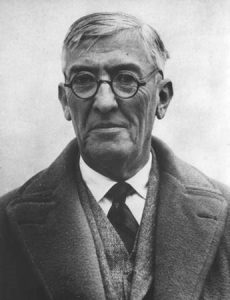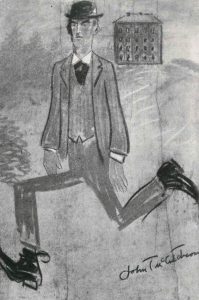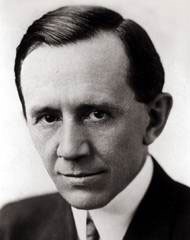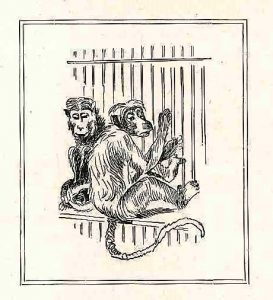George Ade: Worthy Enough to not be Forgotten
*****For the past 8 months (note: this was originally posted May 2016), the Indiana Room had a volunteer intern assisting with the collection. Using a pen name, our intern wrote a blog entry about a part of her experience and something she learned while with the Indiana Room. We hope you enjoy reading this as much as she enjoyed researching and writing it.
George Ade: Worthy Enough to not be Forgotten
By Penny Lane


Do you know who George Ade is? It’s okay if you don’t, I didn’t know him until a few months ago. In a way, though, it’s rather sad. How did an Indiana man, writer of successful plays on Broadway, host of parties entertaining guests including U.S presidents William Harding and William Taft, and author of stories praised by Mark Twain himself, be forgotten?
George Ade was born on February 6th, 1866, in Kentland, Indiana. If you’re not familiar with Kentland, it’s not as far as you might think. In fact, George and his siblings saw the 1871 Chicago Fire from where they were. George was described as a tall, lanky man who had a striking resemblance to Woodrow Wilson, and from early on, he had a knack for learning. His teacher was so impressed with his essay, “A Basket of Potatoes”, they had it published in the local newspaper when George was only fifteen. “Life is but a basket of potatoes,” George had written, “Keep away from the rotten potatoes and you will get to the top.” Little did he know, George would use this writing style years later when he published his famous, “Fables in Slang” stories.
In 1883, when George was seventeen, he decided to attend Purdue in Lafayette, a college which had opened nine years earlier. George decided to study science, and, unsurprisingly, soared in areas of composition and literature, so much so, he became president of the Irving Literary Society.

“George has just heard the dinner bell at the boarding hall”
Besides being president of the Literary Society, George also became president of his fraternity, where he met his greatest comrade, John T. McCutcheon. John was an illustrator, and, along with his older brother, formed a strong friendship with George, which they would keep for many years. George and John’s older brother loved seeing shows at the Lafayette Opera House. George always had an adoration for the world of theater, proven by the plays he would later write.
 John McCutcheon
John McCutcheon
McCutcheon illustration from George Ade’s “Circus Day”
After graduating in 1887, George tried advertising for Cascarets, a laxative brand which he’d named. After reporting for two years, George joined his friend, John, in Chicago to work for the Chicago News, which would later be known as the Record. George’s column, combined with John’s illustrations, “All Road Leads to the Fair” had gained massive popularity at the Columbian Exposition, the 1893 World Fair. The popularity of the column led George to have one of his own, “Stories of the Streets and of the Town.” In it, George didn’t cover anything extravagant, or sophisticated, instead, he wrote about the features of everyday life. Living in Chicago, George had access to foreign immigrants (German, Scandinavian, and Greek to name a few), policeman, shop girls, the poor, and many more characters. George published these columns to eager readers until a man named Herbert Stone wanted to officially publish his work. In 1899, George released “Fables in Slang”.
Ironically, “Fables in Slang” was the exact book that gave my attention to George Ade. One day, while browsing in the Indiana Room of the Crown Point Library, I came across the exact same book. I was greatly amused. “Fables in Slang”? Naturally, I knew what fables were, they were short stories that always gave a moral or a life lesson. The fact that someone had written exactly that, only, in slang, interested me. What shocked me even more was the copyright of the book: 1899. “So not only is it in slang, but late 1800s slang?” I wondered, “I have to read this.”
After finding a take-home copy of “Fables in Slang”, I read through George’s story and found many things in his style. Due to his time studying at Purdue (which included the study of languages), George included German rules into his writing, for example: In German, all nouns are capitalized, George does the same thing, and he also capitalizes for emphasis. Historians are correct for labeling George as a satirist. His stories are meant to be humorous and enjoyable. He doesn’t use satire to be snarky or sharp, but instead to make light of what is usually a negative story. While reading his stories, I was surprised to find how much I understood. As a teenager, it can be hard to understand the context of stories written so long ago, especially with so many unfamiliar words. George’s style is formal, while not losing a sense of casualness. Even if you don’t understand all of the words and phrases, you can still enjoy his work and laugh, instead of constantly referring to a dictionary. Here is an excerpt from one of his fables:
“Once upon a Time there was a Broad Girl who had nothing else to do and no Children to look after, so she thought she would be Benevolent.
She had scared all the Red Corpuscles out of the 2 by 4 Midget who rotated about her in a Limited Orbit and was known by Courtesy as her Husband. He was Soft for her, and so she got it Mapped out with Herself that she was a Superior Woman.
She knew that when she switched the Current on to herself she Used up about 6,000 Ohms an hour, and the whole Neighborhood had to put on the Blinders.”
This was taken from the opening of “The Fable of the Good Fairy with the Lorgnette, and Why She Got it Good.” It talks about a woman so snobbish, “Her clothes were full of Pin-Holes where she had been hanging Medals on Herself, and she used to go in a Hand-Ball Court every Day and throw up Bouquets, letting them bounce back and hit Her.” She goes and visits the poor, who, “Knew how to stand off the Rent-Man and the Dog Catcher; but when 235 pounds of Sunshine came wafting up the Street, they felt that they were up against a New Game.” The story ends with an upset child throwing a tomato can at the woman, after she makes his mother cry. The woman gives up her benevolence. The moral of the fable is ironic, stating: “In uplifting, get underneath.”
After “Fables in Slang”, George’s popularity only grew from there. His book “In Babel” sold 70,000 copies. George’s plays, “The College Widow” and “The Sultan of Sulu” gained massive popularity on Broadway, Chicago, and New York. Getting 5,000 dollars each week in royalties, George eventually purchased the Hazelden estate in Brook, Indiana. There, George was known for throwing extravagant parties, housing celebrities such as Harding, Taft, Charles Dawes. Booth Tarkington, and James Whitcomb Riley.
George had lived a full life. He attended Republican meetings, threw parties, travelled to Asia, Europe, and the Middle East, gave to charity, and helped erect Purdue’s Rose-Ade Stadium. The only thing he never did was marry. George Ade died May 18th, 1944 at age 78. After his death, he faded into obscurity, forgotten with his writings, left to collect dust. As I said in the beginning, it’s quite sad. He was a man beloved by all, not only that, but he came from our home state, and yet, how many of us have a book of his on our shelves? As said in the Dover Edition reprint of “Fables in Slang”, E.F. Bleiler wrote, “Perhaps this long deserved reissue of his earliest collections of fables will bring him the evaluation that he merits, away from…..the complete neglect that he has fallen into. His fables, I am sure, deserve recognition. They are remarkably perceptive, often brilliantly written, and are still funny and pertinent to the American scene.” George Ade may not be one of the most revered names in literature, but he is worth not being left unknown either.
Sources used
“The Best of George Ade” edited by A. L. Lazarus
“Fables in Slang” and “More Fables in Slang” by George Ade
“Circus Day” by George Ade
Photos found online
http://ronevry.com/AdeCatalog.html
http://www.britannica.com/biography/George-Ade


